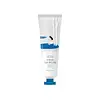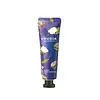What's inside
What's inside
 Key Ingredients
Key Ingredients

 Benefits
Benefits

 Concerns
Concerns

 Ingredients Side-by-side
Ingredients Side-by-side

Water
Skin ConditioningGlycerin
HumectantCaprylic/Capric Triglyceride
MaskingButyrospermum Parkii Butter
Skin ConditioningCetearyl Alcohol
EmollientCetearyl Olivate
Isononyl Isononanoate
EmollientSqualane
EmollientSorbitan Olivate
EmulsifyingDipropylene Glycol
HumectantAcrylates/C10-30 Alkyl Acrylate Crosspolymer
Emulsion StabilisingParfum
MaskingTromethamine
BufferingHydroxyethyl Acrylate/Sodium Acryloyldimethyl Taurate Copolymer
Emulsion StabilisingHydroxyacetophenone
AntioxidantCaprylyl Glycol
EmollientBetula Platyphylla Japonica Juice
Skin ConditioningEthylhexylglycerin
Skin ConditioningAdenosine
Skin ConditioningSorbitan Isostearate
EmulsifyingDisodium EDTA
Dipotassium Glycyrrhizate
HumectantButylene Glycol
HumectantGlyceryl Glucoside
HumectantHydrogenated Lecithin
EmulsifyingGlyceryl Caprylate
EmollientStearic Acid
Cleansing1,2-Hexanediol
Skin ConditioningTocopherol
AntioxidantSodium Hyaluronate
HumectantHydrolyzed Keratin
HumectantCeramide NP
Skin ConditioningCeramide Ns
Skin ConditioningCholesterol
EmollientHydrolyzed Hyaluronic Acid
HumectantPhytosphingosine
Skin ConditioningHyaluronic Acid
HumectantCeramide AP
Skin ConditioningCeramide As
Skin ConditioningAscorbic Acid
AntioxidantSodium Acetylated Hyaluronate
HumectantCeramide EOP
Skin ConditioningWater, Glycerin, Caprylic/Capric Triglyceride, Butyrospermum Parkii Butter, Cetearyl Alcohol, Cetearyl Olivate, Isononyl Isononanoate, Squalane, Sorbitan Olivate, Dipropylene Glycol, Acrylates/C10-30 Alkyl Acrylate Crosspolymer, Parfum, Tromethamine, Hydroxyethyl Acrylate/Sodium Acryloyldimethyl Taurate Copolymer, Hydroxyacetophenone, Caprylyl Glycol, Betula Platyphylla Japonica Juice, Ethylhexylglycerin, Adenosine, Sorbitan Isostearate, Disodium EDTA, Dipotassium Glycyrrhizate, Butylene Glycol, Glyceryl Glucoside, Hydrogenated Lecithin, Glyceryl Caprylate, Stearic Acid, 1,2-Hexanediol, Tocopherol, Sodium Hyaluronate, Hydrolyzed Keratin, Ceramide NP, Ceramide Ns, Cholesterol, Hydrolyzed Hyaluronic Acid, Phytosphingosine, Hyaluronic Acid, Ceramide AP, Ceramide As, Ascorbic Acid, Sodium Acetylated Hyaluronate, Ceramide EOP
Water
Skin ConditioningGlycerin
HumectantCetyl Alcohol
EmollientParaffinum Liquidum
EmollientDipropylene Glycol
HumectantDimethicone
EmollientCyclopentasiloxane
EmollientStearyl Alcohol
EmollientGlyceryl Stearate
EmollientPEG-100 Stearate
Polysorbate 60
EmulsifyingMyristyl Alcohol
EmollientSorbitan Stearate
EmulsifyingAcrylates/C10-30 Alkyl Acrylate Crosspolymer
Emulsion StabilisingSqualane
EmollientErythritol
HumectantButyrospermum Parkii Butter
Skin ConditioningLauryl Alcohol
EmollientCoco-Caprylate/Caprate
EmollientButylene Glycol
HumectantXanthan Gum
EmulsifyingPotassium Hydroxide
BufferingAdenosine
Skin ConditioningVitis Vinifera Seed Oil
EmollientPrunus Armeniaca Kernel Oil
MaskingPanthenol
Skin ConditioningSolanum Lycopersicum Seed Oil
EmollientPunica Granatum Seed Oil
EmollientMangifera Indica Seed Oil
EmollientCitrus Paradisi Seed Oil
PerfumingHoney Extract
HumectantCentella Asiatica Extract
CleansingTocopherol
AntioxidantDisodium EDTA
Phenoxyethanol
PreservativeChlorphenesin
Antimicrobial1,2-Hexanediol
Skin ConditioningParfum
MaskingLimonene
PerfumingPrunus Persica Fruit Extract
AbrasiveHydroxycitronellal
PerfumingEuterpe Oleracea Fruit Extract
Coumarin
PerfumingCitronellol
PerfumingLinalool
PerfumingButylphenyl Methylpropional
PerfumingPrunus Serotina Fruit Extract
MaskingPunica Granatum Fruit Extract
AntioxidantBenzyl Salicylate
PerfumingGeraniol
PerfumingCitrus Unshiu Peel Extract
MaskingVaccinium Angustifolium Fruit Extract
Skin ProtectingHexyl Cinnamal
PerfumingCocos Nucifera Water
MaskingBenzyl Benzoate
AntimicrobialCitral
PerfumingWater, Glycerin, Cetyl Alcohol, Paraffinum Liquidum, Dipropylene Glycol, Dimethicone, Cyclopentasiloxane, Stearyl Alcohol, Glyceryl Stearate, PEG-100 Stearate, Polysorbate 60, Myristyl Alcohol, Sorbitan Stearate, Acrylates/C10-30 Alkyl Acrylate Crosspolymer, Squalane, Erythritol, Butyrospermum Parkii Butter, Lauryl Alcohol, Coco-Caprylate/Caprate, Butylene Glycol, Xanthan Gum, Potassium Hydroxide, Adenosine, Vitis Vinifera Seed Oil, Prunus Armeniaca Kernel Oil, Panthenol, Solanum Lycopersicum Seed Oil, Punica Granatum Seed Oil, Mangifera Indica Seed Oil, Citrus Paradisi Seed Oil, Honey Extract, Centella Asiatica Extract, Tocopherol, Disodium EDTA, Phenoxyethanol, Chlorphenesin, 1,2-Hexanediol, Parfum, Limonene, Prunus Persica Fruit Extract, Hydroxycitronellal, Euterpe Oleracea Fruit Extract, Coumarin, Citronellol, Linalool, Butylphenyl Methylpropional, Prunus Serotina Fruit Extract, Punica Granatum Fruit Extract, Benzyl Salicylate, Geraniol, Citrus Unshiu Peel Extract, Vaccinium Angustifolium Fruit Extract, Hexyl Cinnamal, Cocos Nucifera Water, Benzyl Benzoate, Citral
 Reviews
Reviews

Ingredients Explained
These ingredients are found in both products.
Ingredients higher up in an ingredient list are typically present in a larger amount.
1,2-Hexanediol is a synthetic liquid and another multi-functional powerhouse.
It is a:
- Humectant, drawing moisture into the skin
- Emollient, helping to soften skin
- Solvent, dispersing and stabilizing formulas
- Preservative booster, enhancing the antimicrobial activity of other preservatives
Acrylates/C10-30 Alkyl Acrylate Crosspolymer is a synthetic polymer. It is used to thicken and improve the texture of products. Due to its properties, it can prevent water and oil ingredients from separating.
Adenosine is in every living organism. It is one of four components in nucleic acids that helps store our DNA.
Adenosine has many benefits when used. These benefits include hydrating the skin, smoothing skin, and reducing wrinkles. Once applied, adenosine increases collagen production. It also helps with improving firmness and tissue repair.
Studies have found adenosine may also help with wound healing.
In skincare products, Adenosine is usually derived from yeast.
Learn more about AdenosineButylene Glycol (or BG) is used within cosmetic products for a few different reasons:
Overall, Butylene Glycol is a safe and well-rounded ingredient that works well with other ingredients.
Though this ingredient works well with most skin types, some people with sensitive skin may experience a reaction such as allergic rashes, closed comedones, or itchiness.
Learn more about Butylene GlycolThis ingredient is also known as shea butter. It is an effective skin hydrator and emollient.
Emollients help soothe and soften your skin. It does this by creating a protective film on your skin. This barrier helps trap moisture and keeps your skin hydrated. Emollients may be effective at treating dry or itchy skin.
Shea butter is rich in antioxidants. Antioxidants help fight free-radicals, or molecules that may harm the body. It is also full of fatty acids including stearic acid and linoleic acid. These acids help replenish the skin and keep skin moisturized.
While Shea Butter has an SPF rating of about 3-4, it is not a sunscreen replacement.
Shea butter may not be fungal acne safe. We recommend speaking with a professional if you have any concerns.
Learn more about Butyrospermum Parkii ButterDipropylene Glycol is a synthetically created humectant, stabilizer, and solvent.
This ingredient helps:
Dipropylene glycol is technically an alcohol, but it belongs to the glycol family (often considered part of the ‘good’ alcohols). This means it is hydrating and gentle on skin unlike drying solvent alcohols like denatured alcohol.
As a masking agent, Dipropylene Glycol can be used to cover the smell of other ingredients. However, it does not have a scent.
Studies show Dipropylene Glycol is considered safe to use in skincare.
Learn more about Dipropylene GlycolDisodium EDTA plays a role in making products more stable by aiding other preservatives.
It is a chelating agent, meaning it neutralizes metal ions that may be found in a product.
Disodium EDTA is a salt of edetic acid and is found to be safe in cosmetic ingredients.
Learn more about Disodium EDTAGlycerin is already naturally found in your skin. It helps moisturize and protect your skin.
A study from 2016 found glycerin to be more effective as a humectant than AHAs and hyaluronic acid.
As a humectant, it helps the skin stay hydrated by pulling moisture to your skin. The low molecular weight of glycerin allows it to pull moisture into the deeper layers of your skin.
Hydrated skin improves your skin barrier; Your skin barrier helps protect against irritants and bacteria.
Glycerin has also been found to have antimicrobial and antiviral properties. Due to these properties, glycerin is often used in wound and burn treatments.
In cosmetics, glycerin is usually derived from plants such as soybean or palm. However, it can also be sourced from animals, such as tallow or animal fat.
This ingredient is organic, colorless, odorless, and non-toxic.
Glycerin is the name for this ingredient in American English. British English uses Glycerol/Glycerine.
Learn more about GlycerinParfum is a catch-all term for an ingredient or more that is used to give a scent to products.
Also called "fragrance", this ingredient can be a blend of hundreds of chemicals or plant oils. This means every product with "fragrance" or "parfum" in the ingredients list is a different mixture.
For instance, Habanolide is a proprietary trade name for a specific aroma chemical. When used as a fragrance ingredient in cosmetics, most aroma chemicals fall under the broad labeling category of “FRAGRANCE” or “PARFUM” according to EU and US regulations.
The term 'parfum' or 'fragrance' is not regulated in many countries. In many cases, it is up to the brand to define this term.
For instance, many brands choose to label themselves as "fragrance-free" because they are not using synthetic fragrances. However, their products may still contain ingredients such as essential oils that are considered a fragrance by INCI standards.
One example is Calendula flower extract. Calendula is an essential oil that still imparts a scent or 'fragrance'.
Depending on the blend, the ingredients in the mixture can cause allergies and sensitivities on the skin. Some ingredients that are known EU allergens include linalool and citronellol.
Parfum can also be used to mask or cover an unpleasant scent.
The bottom line is: not all fragrances/parfum/ingredients are created equally. If you are worried about fragrances, we recommend taking a closer look at an ingredient. And of course, we always recommend speaking with a professional.
Learn more about ParfumSqualane is an emollient that helps the skin hold onto moisture. It's an oily liquid that occurs naturally in certain types of fish and plant oils.
Because squalane boosts hydration in the skin, it also comes with plenty of benefits: it is an antioxidant and can help fight free radicals and skin damage. Squalane is also found to have a detoxifying effect when applied.
Squalane comes from squalene, which occurs naturally within the sebum of our skin. It is one of the oils our skin produces to keep itself hydrated. Squalane is the hydrogenated version of squalene and has a longer shelf life.
Research shows that squalane is non-irritating (even at 100% concentration).
In general, it's a fantastic ingredient. It does a great job at hydrating the skin, and it's suitable for those with sensitive skin.
The source of squalane may impact malassezia / fungal acne. This is because olive oil derived squalane can contain impurities such as fatty acids and plant waxes. Sugarcane derived squalane is recommended for anyone with malassezia concerns.
Is squalane vegan?
This depends on the source. Squalane can be derived from both plants and animals. Most squalane used in skincare comes from plants.
Please note: the source of squalane is only known if disclosed by the brand. We recommend reaching out to the brand if you have any questions about their squalane.
Read more about squalene with an "e".
Is squalane an oil?
Squalane is often called an oil, but it’s technically not; it’s a hydrocarbon, meaning it’s only made of carbon and hydrogen, unlike true oils which are triglycerides made of fatty acids and glycerol.
The term “oil-free” isn’t regulated, so companies can define it however they want. Some exclude all oils, while others just avoid mineral oil or comedogenic oils.
While some people avoid oils thinking they cause breakouts, the right kind of oil (or oil-like ingredient like squalane) can actually help balance and hydrate your skin. It’s worth testing out simple oils or squalane to see what works best for your skin.
Learn more about SqualaneTocopherol (also known as Vitamin E) is a common antioxidant used to help protect the skin from free-radicals and strengthen the skin barrier. It's also fat soluble - this means our skin is great at absorbing it.
Vitamin E also helps keep your natural skin lipids healthy. Your lipid skin barrier naturally consists of lipids, ceramides, and fatty acids. Vitamin E offers extra protection for your skin’s lipid barrier, keeping your skin healthy and nourished.
Another benefit is a bit of UV protection. Vitamin E helps reduce the damage caused by UVB rays. (It should not replace your sunscreen). Combining it with Vitamin C can decrease sunburned cells and hyperpigmentation after UV exposure.
You might have noticed Vitamin E + C often paired together. This is because it is great at stabilizing Vitamin C. Using the two together helps increase the effectiveness of both ingredients.
There are often claims that Vitamin E can reduce/prevent scarring, but these claims haven't been confirmed by scientific research.
Learn more about TocopherolWater. It's the most common cosmetic ingredient of all. You'll usually see it at the top of ingredient lists, meaning that it makes up the largest part of the product.
So why is it so popular? Water most often acts as a solvent - this means that it helps dissolve other ingredients into the formulation.
You'll also recognize water as that liquid we all need to stay alive. If you see this, drink a glass of water. Stay hydrated!
Learn more about Water